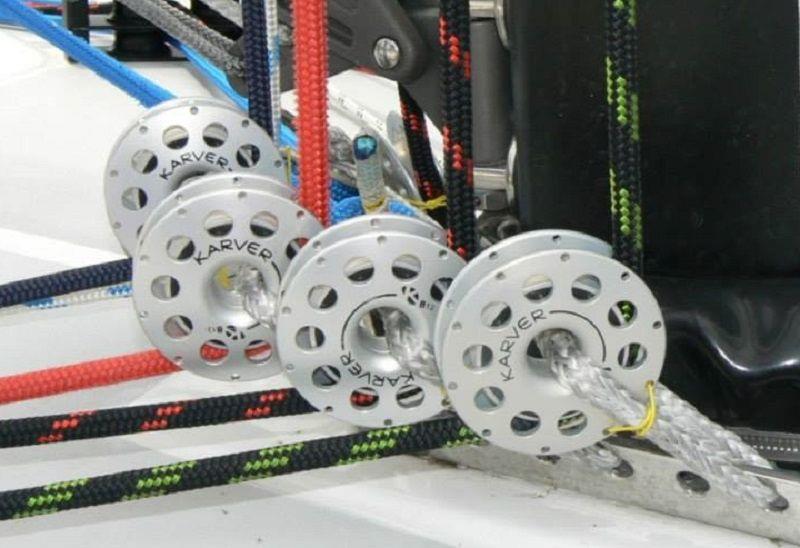
The Difference Between Plain, Ball and Roller Bearings - from Upffront
by Diego Sosa, Upffront 23 Jul 2018 04:00 PDT

Karver KB blocks at mast base © Karver Systems
Deck blocks are evolving. Bearings are constantly improving, as manufacturers endeavour to minimize friction in different load cases.
Types of bearings
Apart from number of sheaves, blocks can also be categorised by their bearings.
- Plain bearings: Although the name itself sounds quite vague, these are smooth, solid surfaces that
move across each other. The sheave rotates across the central hub.
- Ball bearings: Small spherical balls have little contact between surfaces, resulting in low friction. However, ball surfaces can be deformed under heavier loads, resulting in the jamming of the block,
- Roller bearings: 'Rollers' are small tubes arranged around the centre of the bearing. Rollers are a 'compromise' between the plain and balls. Rollers wear faster than ball bearings but can carry higher loads as they have a higher contact area.
Different applications:
- Plain Bearings
The earliest (and original!) blocks used plain bearings, but they have slowly given way to higher-performing bearings. Plain bearings have the least number of moving parts. A long lifespan and low maintenance with heavy load applications are the main benefits of plain bearings.
Metal or plastic sheaves roll directly on metal pins or bushings. Plain bearings are often comprised of a plastic surface and a metal shell. Another common kind of plain bearing will use a soft bronze bushing and a polished steel shaft. Their static and high-load capability make plain bearings suitable for vangs, backstay, runner and halyard turning blocks. However, full contact between two surfaces results in more friction, reducing their potential running speed.
- Ball Bearings
Ball bearings were the response to reduce this friction and they do this job extremely well. However, the small contact surface of the balls, which reduces the friction so much, is also their biggest weakness i.e. the point loading of the balls can lead to compression, at high loads and the block jamming. Ball bearings are high performance blocks suited to running at high speeds, but their size and weight increase significantly as loads rise. So, the R+D for block bearings wasn't finished at this stage.
- Roller Bearings
Roller bearings were the compromise between plain and ball bearings. Rollers facilitate low friction at high working loads. Heavily-loaded lines run faster, smoother and are more easily adjusted compared to a plain bearing block. They can also be smaller and lighter than a ball bearing block, for the same working load, due to the increased contact between the rollers and the hub.
Found on sailing boats of 35'+, these blocks are optimal for mainsheets, guy leads, backstays, after guys and tack lines.
For larger boats, blocks use a blend of ball and roller bearings. Roller bearings take the main line loads, leaving the ball bearings mounted around either edge to keep the sheave running smoothly, even with off-axis loads. This can be seen in the '2-Stage bearing system' of the Ronstan Core Blocks.
What are bearings made from?
Ball and roller bearings are commonly manufactured with the following materials:
- Delrin - Commonly found in deck blocks and known as 'acetal'. This is a thermoplastic specially designed for high compression, but low tension, thus suitable for low loads.
- Torlon - Is the commercial name given to the high-performance thermoplastic composite material and offer a performance upgrade to Delrin balls.
- Ceramic - Ceramic ball bearings are incredibly strong and can be polished to incredibly smooth surfaces. This enables them to handle extraordinary heavy loads with very low friction but their cost generally limits them to Grand Prix level blocks.
For many years, the backbone of most block ranges were heavy plastics with aluminium or stainless steel structural side plates, which were used to transfer loads. As computing power advanced, designers modelled crucial load paths accurately to ensure sufficient strength from modern, lightweight composite materials. Today, blocks are lighter and smaller than those used a decade ago, making them perfect for the thinner hi-tech lines / ropes.
Perhaps another step of this evolution is the current shift towards rope blocks and lash thimbles on Dyneema® loops.
This is merely a modern evolution of the plain bearing block, but it has sparked furious debate: is it a real block or just a friction sheave?
About Upffront.com
Our focus is on sailing systems and our aim is to improve knowledge and accessibility to the latest developments in lightweight, composite rigging and promote lighter, faster, safer sailing for boats of all shapes and sizes from dinghies to superyachts.
Improve knowledge and accessibility